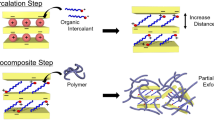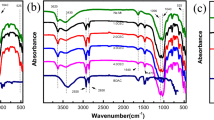Abstract
IT has been shown by X-ray analysis that certain organic compounds are taken up between the basal surfaces of montmorillonite and halloysite to form interlamellar complexes. The space occupied by the organic molecules is determined by subtracting the van der Waals thickness of individual clay sheets from the observed (001) spacing, and is normally less than that calculated by assuming that the molecules lie as flat as possible and also make van der Waals contact with the surface atoms of the clay. The apparent reduction in thickness has been ascribed to CH … O bonds1–3 between the oxygen atoms of the clay surface, which have an induced negative charge arising from the isomorphous replacement charge, and the organic molecules. Polyvinyl alcohol, the crysta structure of which has been determined, appears to form a two-layer complex with montmorillonite in which there is van der Waals contact between the —CH2 groups and the surface oxygen atoms, and the plane of the carbon chains is perpendicular to the (001) planes (unpublished work). This suggested that the orientation of the simple alcohols might be such that the plane of the carbon chain is perpendicular to the (001) plane, and not parallel as originally assumed1,2,4. The most recent evidence is also against the latter assumption5.
This is a preview of subscription content, access via your institution
Access options
Subscribe to this journal
Receive 51 print issues and online access
$199.00 per year
only $3.90 per issue
Buy this article
- Purchase on Springer Link
- Instant access to full article PDF
Prices may be subject to local taxes which are calculated during checkout
Similar content being viewed by others
References
Bradley, W. F., J. Amer. Chem. Soc., 67, 975 (1945).
MacEwan, D. M. C., Trans. Farad. Soc., 44, 349 (1948).
Talibudeen, O., Trans. Farad. Soc., 51, 412 (1955).
Jordan, J. W., Min. Mag., 28, 598 (1949).
Greene-Kelly, R., Trans. Farad. Soc., 52, 1281 (1956).
Pauling, L., “The Nature of the Chemical Bond” (Cornell Univ. Press, Ithaca, N.Y., 1940).
Glaeser, R., C.R. Acad. Sci., Paris, A, 226, 935 (1948).
Author information
Authors and Affiliations
Rights and permissions
About this article
Cite this article
EMERSON, W. Organo-Clay Complexes. Nature 180, 48–49 (1957). https://doi.org/10.1038/180048b0
Issue Date:
DOI: https://doi.org/10.1038/180048b0
This article is cited by
-
Thermal characterization of methyltributylammonium-smectites
Journal of Thermal Analysis and Calorimetry (2008)
-
Chemically bonded stationary phases for gas and high performance liquid chromatography
Chromatographia (1976)
-
Liquid-solid chromatography on bentone-34
Chromatographia (1972)
Comments
By submitting a comment you agree to abide by our Terms and Community Guidelines. If you find something abusive or that does not comply with our terms or guidelines please flag it as inappropriate.



